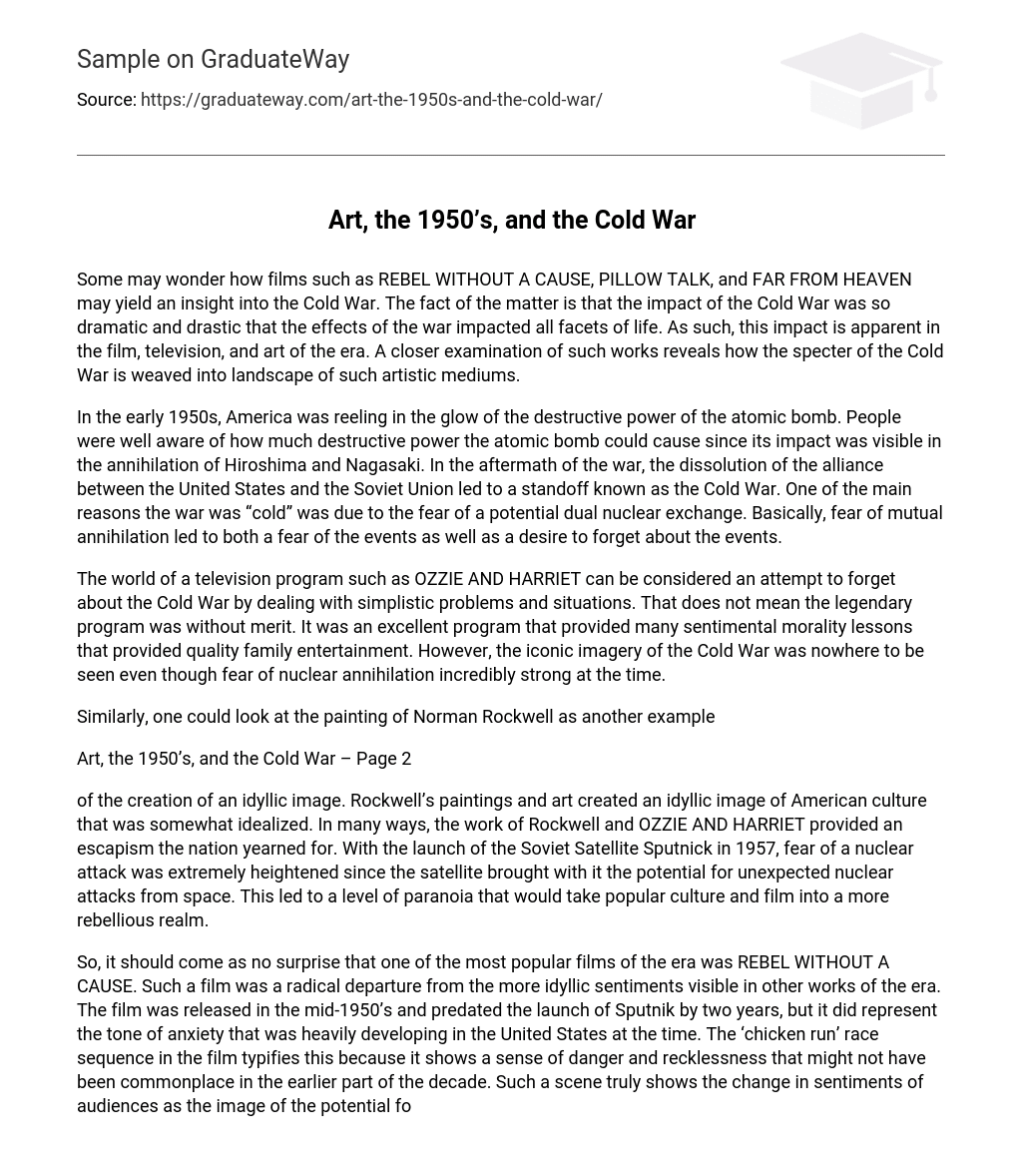Some may wonder how films such as REBEL WITHOUT A CAUSE, PILLOW TALK, and FAR FROM HEAVEN may yield an insight into the Cold War. The fact of the matter is that the impact of the Cold War was so dramatic and drastic that the effects of the war impacted all facets of life. As such, this impact is apparent in the film, television, and art of the era. A closer examination of such works reveals how the specter of the Cold War is weaved into landscape of such artistic mediums.
In the early 1950s, America was reeling in the glow of the destructive power of the atomic bomb. People were well aware of how much destructive power the atomic bomb could cause since its impact was visible in the annihilation of Hiroshima and Nagasaki. In the aftermath of the war, the dissolution of the alliance between the United States and the Soviet Union led to a standoff known as the Cold War. One of the main reasons the war was “cold” was due to the fear of a potential dual nuclear exchange. Basically, fear of mutual annihilation led to both a fear of the events as well as a desire to forget about the events.
The world of a television program such as OZZIE AND HARRIET can be considered an attempt to forget about the Cold War by dealing with simplistic problems and situations. That does not mean the legendary program was without merit. It was an excellent program that provided many sentimental morality lessons that provided quality family entertainment. However, the iconic imagery of the Cold War was nowhere to be seen even though fear of nuclear annihilation incredibly strong at the time.
Similarly, one could look at the painting of Norman Rockwell as another example
Art, the 1950’s, and the Cold War – Page 2
of the creation of an idyllic image. Rockwell’s paintings and art created an idyllic image of American culture that was somewhat idealized. In many ways, the work of Rockwell and OZZIE AND HARRIET provided an escapism the nation yearned for. With the launch of the Soviet Satellite Sputnick in 1957, fear of a nuclear attack was extremely heightened since the satellite brought with it the potential for unexpected nuclear attacks from space. This led to a level of paranoia that would take popular culture and film into a more rebellious realm.
So, it should come as no surprise that one of the most popular films of the era was REBEL WITHOUT A CAUSE. Such a film was a radical departure from the more idyllic sentiments visible in other works of the era. The film was released in the mid-1950’s and predated the launch of Sputnik by two years, but it did represent the tone of anxiety that was heavily developing in the United States at the time. The ‘chicken run’ race sequence in the film typifies this because it shows a sense of danger and recklessness that might not have been commonplace in the earlier part of the decade. Such a scene truly shows the change in sentiments of audiences as the image of the potential for a third world war was very real.
Some could even argue that the experimental artwork of Jackson Pollock displays the extreme paranoia some felt towards a nuclear war. Highly erratic and almost chaotic, Pollock’s art was far removed from the work of Rockwell. Again, the image of the Cold War was altering the complacency and normalcy American life was commonly accustomed to.
Art, the 1950’s, and the Cold War – Page 3
But, did society ever reach the point where enough was enough with the fear of the Cold War? By the late 1950s, fear was giving way to escapism. We see this in the classic bedroom farce PILLOW TALK. The silly – and humorous – scene where Brad uses a phony Texas accent to pick up on Jan can be seen as symbolic of the nation seeking to hide behind a different persona. The world is too bleak and bleary in its ‘real’ state. So, the populace seeks to venture into escapism to avoid the potential horrors the Cold War yields. Such a head-in-the-sand approach does nothing to stop or curtail the Cold War but it provides a sense of escapist comfort. Considering that nothing could be done during the late 1950s to stop worsening military tensions, escapism and hiding could prove to be the only strategy the populace could employ for self-protection.
While made in 2002, but set in the 1950s, FAR FROM HOME also contains such similar imagery of hiding who you are. The scene where the wife walks in on her husband kissing another man could have various Cold War era symbolism. It could, for example, be indicative of McCarthyism with hiding homosexuality being symbolic of hiding communist ties. It could also entail the paranoid fear of being “outed” with the paranoid fear of being attacked by nuclear strikes. Ultimately, the scene betrays the image of paranoia that the later 1950s had become known for.
This is not to say that the era would be completely defined by either escapism or rebellion or paranoia. But, it would be safe to conclude that the Cold War was the even that completely defined the 1950s. As such, the permeation of imagery and themes form the Cold War envelope many different components of popular culture at the time. Again,
Art, the 1950’s, and the Cold War – Page 3
this should not prove surprising since fear of the impact of the Cold War turning into an actual third world war truly did grip the nation in tremendous fear.





